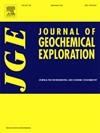综合奇点-能量分析揭示矿化相关地球化学模式
IF 3.3
2区 地球科学
Q1 GEOCHEMISTRY & GEOPHYSICS
引用次数: 0
摘要
在过去的二十年中,局部奇异分析(LSA)已成为一种领先的技术,用于增强与复杂地球系统中非线性成矿过程相关的弱地球化学异常。综合多成矿元素的奇异图,可以更好地揭示多元素地球化学异常,并将其描绘为与成矿有关的更强的地球化学特征。因此,异常成分分类对于识别与成矿有关的地球化学异常的不同模式至关重要,是为确定金属找矿靶区迈出的一步。针对多成矿元素奇点填图所得金属富集模式的多样性,提出了奇点-能量(S-E)综合分析方法。根据S-E方法,将LSA应用于栅格化地球化学图,目的是减少覆盖层的不利影响,增强弱地球化学异常。基于多样本能量统计,设计基于能量距离的k群划分方法,将奇点图划分为k种不同概率分布的模式,从而识别不同的多元素地球化学异常模式。最后,计算得到的S-E模式的远景指数,以优先考虑与矿化有关的模式,并自动定义勘探目标。伊朗东北部Moalleman地区的水系沉积物地球化学数据集(即Cu、Au、Pb和Zn)证明了S-E分析的潜在应用。此外,利用可加性地球化学指数的浓度-面积多重分形模型和成矿元素奇异图的k-means聚类方法识别出了其他地球化学模式,作为构成对比分析的传统参考。成功率曲线评价表明,与传统方法相比,S-E分析得到的金属富集模式与研究区内热液型和低温热液型成矿事件在空间上具有更强的一致性。研究结果表明,该技术具有强大的性能,可为复杂地球系统中埋藏和覆盖金属矿床的找矿提供更有效的勘探知识和可靠的证据。本文章由计算机程序翻译,如有差异,请以英文原文为准。
An integrated singularity–energy analysis to reveal mineralization-related geochemical patterns
During the last two decades, local singularity analysis (LSA) has become a leading technique to enhance weak geochemical anomalies associated with non-linear ore-forming processes operating in complex Earth systems. Singularity maps of multiple ore-forming elements are preferably synthesized to reveal multi-element geochemical anomalies and to portray them as stronger mineralization-related geochemical signatures. In this regard, classifying anomalous components is crucial to identify different patterns of ore formation-related geochemical anomalies, a step forward to delimit target areas for metal exploration. This research puts forward an integrated singularity–energy (S–E) analysis dealing with the variety in the metal enrichment patterns obtained from singularity mapping of multiple ore-forming elements. As per the S–E methodology, the LSA is applied to the rasterized geochemical maps with the aim of reducing the adverse effects of overburden and enhancing weak geochemical anomalies. Relying on multi-sample energy statistics, a k-groups partitioning based on energy distance is then devised to classify singularity maps into patterns with contrasting probability distributions, thereby recognizing different patterns of multi-element geochemical anomalies. Eventually, prospectivity indices for the resulting S–E patterns are calculated to prioritize mineralization-related patterns and to automate the definition of exploration targets. The potential application of the S–E analysis is demonstrated by a stream sediment geochemical dataset (viz. Cu, Au, Pb, and Zn) pertaining to the Moalleman district, NE Iran. Moreover, additional geochemical patterns are recognized by concentration–area multifractal modeling of additive geochemical indices and by k-means clustering of singularity maps of ore-forming elements, serving as traditional references to constitute comparative analyses. Appraisal by success-rate curves indicates that metal enrichment patterns derived from S–E analysis, compared to those from traditional approaches, establish a more significant spatial conformity with hydrothermal- and epithermal-type mineralization events within the study area. The findings suggest that the proposed technique has robust properties to bring more efficient exploration knowledge and reliable evidence for prospecting buried and covered metal deposits within complex Earth systems.
求助全文
通过发布文献求助,成功后即可免费获取论文全文。
去求助
来源期刊

Journal of Geochemical Exploration
地学-地球化学与地球物理
CiteScore
7.40
自引率
7.70%
发文量
148
审稿时长
8.1 months
期刊介绍:
Journal of Geochemical Exploration is mostly dedicated to publication of original studies in exploration and environmental geochemistry and related topics.
Contributions considered of prevalent interest for the journal include researches based on the application of innovative methods to:
define the genesis and the evolution of mineral deposits including transfer of elements in large-scale mineralized areas.
analyze complex systems at the boundaries between bio-geochemistry, metal transport and mineral accumulation.
evaluate effects of historical mining activities on the surface environment.
trace pollutant sources and define their fate and transport models in the near-surface and surface environments involving solid, fluid and aerial matrices.
assess and quantify natural and technogenic radioactivity in the environment.
determine geochemical anomalies and set baseline reference values using compositional data analysis, multivariate statistics and geo-spatial analysis.
assess the impacts of anthropogenic contamination on ecosystems and human health at local and regional scale to prioritize and classify risks through deterministic and stochastic approaches.
Papers dedicated to the presentation of newly developed methods in analytical geochemistry to be applied in the field or in laboratory are also within the topics of interest for the journal.
 求助内容:
求助内容: 应助结果提醒方式:
应助结果提醒方式:


